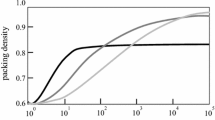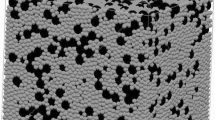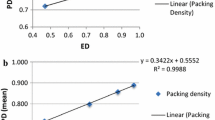Abstract
The study of particle-packing models for bi-dispersed packings is important in the field of granular materials, from both theoretical and practical perspectives. Several particle-packing models have been developed for predicting the packing density (or specific volume) of a bi-dispersed packing. Most of the currently available models are phenomenological, which predict the specific volumes of a bi-dispersed packing as a function of fraction of species, and have applied to various fields, such as in concrete, pharmaceutical, soil engineering, etc. In this study, we analyze the packing densities of granular mixtures using an analogy to the thermodynamic theory for chemical solutions. The thermodynamic theory for chemical solutions provides the connections among the bulk solution density, the chemical interaction activities between species, and the concentration of each species in the solution. Parallel to the chemical potential of each species in the solution, we introduce an “excess free volume potential” for each granular species. With the interaction activities of two species in a bi-dispersed granular system, we explain the volume compaction behavior of a granular system from a new context. Subsequently, using the second law of thermodynamics, an analytical method is proposed to quantify the excess free volume potentials and to predict the density of a granular mixture. The developed analytical method is then validated by the experimental results of bi-dispersed packing mixtures of glass beads and silica sands. The performance of the analytical method and its validity are demonstrated.















Similar content being viewed by others
Abbreviations
- \(V\) :
-
Total volume of a bi-dispersed packing
- \(\upsilon\) :
-
Specific volume of a bi-dispersed packing
- \(V_{1}^{0} ,V_{2}^{0}\) :
-
Total volumes of each component in mono-dispersed packing state
- \(\upsilon _{1}^{0}, \upsilon _{2}^{0}\) :
-
Specific volumes of each component in mono-dispersed packing state
- \(N_{1} ,N_{2}\) :
-
Total number of large particles and small particles in a bi-dispersed packing
- \(y_{1} ,y_{2}\) :
-
Solid volume fraction of each component in a bi-dispersed packing
- \({\text{v}}_{1}^{g}, {\text{v}}_{2}^{g}\) :
-
Particle solid volume of each component in a bi-dispersed packing
- \(d_{1} ,d_{2}\) :
-
Particle size of each component in a bi-dispersed packing
- \({\text{v}}_{1}^{m}, {\text{v}}_{2}^{m}\) :
-
Particle volume potential of the mth particle of each component in a bi-dispersed packing
- \({\text{v}}_{1}^{0} ,{\text{v}}_{2}^{0}\) :
-
Average particle volume potential of each component in mono-dispersed packing state
- \({\text{v}}_{1} ,{\text{v}}_{2}\) :
-
Average particle volume potential of each component in a bi-dispersed packing
- X :
-
Compactivity (granular temperature)
- S :
-
Granular entropy
- \(V^{\prime}, V\) :
-
Internal volume potential, Gibbs volume potential
- \(\zeta\) :
-
Extent of reaction
- \(\Delta V\) :
-
Excess free volume potential of the bi-dispersed packing
- \(\Delta {\text{v}}_{1} ,\Delta {\text{v}}_{2}\) :
-
Excess free volume potential for each component in a bi-dispersed packing
- \(\alpha _{1}, \alpha _{2}\) :
-
Interaction activity coefficients for each component in a bi-dispersed packing
- \(r_{i}\) :
-
Particle size ratio
- \(\eta _{1}, \eta _{2} (\eta)\) :
-
Material parameter for each component (averaged value)
- \(\bar{x}\) :
-
Internal state variable
References
An, X.Z.: Densification of the packing structure under vibrations. Int. J. Miner. Metall. Mater. 20, 499–503 (2013). https://doi.org/10.1007/s12613-013-0757-9
Aste, T., Saadatfar, M., Senden, J.T.: Local and global relations between the number of contacts and density in monodisperse sphere packs. J. Stat. Mech. (2006). https://doi.org/10.1088/1742-5468/2006/07/P07010
ASTM D4253-00: Standard test methods for maximum index density and unit weight of soils using a vibratory table. In: Annual Book of ASTM Standards. ASTM International, West Conshohocken, pp. 1–15 (2006). https://doi.org/10.1520/D4253-00R06
Atkins, P., dePaula, J.: Section 5.9, the activities of ions in solution. In: Physical Chemisrry, 8th edn. OUP. ISBN: 9780198700722 (2006)
Baule, A., Morone, F., Herrmann, H.J., Makse, H.A.: Edwards statistical mechanics for jammed granular matter. Rev. Mod. Phys. 90, 15006 (2018). https://doi.org/10.1103/RevModPhys.90.015006
Blumenfeld, R., Amitai, S., Jordan, J., Hihinashvili, R.: Failure of the volume function in granular statistical mechanics. Phys. Rev. Lett. 116, 148001 (2016)
Blumenfeld, R., Edwards, S.: Geometric partition functions of cellular systems: explicit calculation of the entropy in two and three dimensions. Eur. Phys. J. E 19, 23–30 (2006)
Blumenfeld, R., Edwards, S.F.: On granular stress statistics: compactivity, angoricity, and some ppen issues. J. Phys. Chem. B 113, 3981–3987 (2009). https://doi.org/10.1021/jp809768y
BS 182: Testing Aggregates Part 2: Methods of Determination of Density. British Standards Institution (1995)
Chang, C.S., Deng, Y.: A particle packing model for sand–silt mixtures with the effect of dual-skeleton. Granul. Matter (2017). https://doi.org/10.1007/s10035-017-0762-1
Cheng, G., Yu, A., Zulli, P.: Evaluation of effective thermal conductivity from the structure of a packed bed. Chem. Eng. Sci. 54, 4199–4209 (1999)
Cho, Y.T.: The Study of GCTS Triaxial Apparatus Function and Mixing Sand Void Ratio. National Taiwan University (2014)
Clarke, A.S., Wiley, J.D.: Numerical simulation of the dense random packing of a binary mixture of hard spheres: amorphous metals. Phys. Rev. B 35, 7350–7356 (1987). https://doi.org/10.1103/PhysRevB.35.7350
Coleman, B., Gurtin, M.: Thermodynamics with internal state variables. J. Chem. Phys. 47, 597 (1967). https://doi.org/10.1063/1.1711937
da Cruz, F., Lechenault, F., Dauchot, O., Bertin, E.: Free volume distributions inside a bidimensional granular medium. In: Herrmann, H.J., Garcia-Rojo, R., McNamara, S. (eds.) Powders and Grains 2005. CRC Press, Stuttgart (2005)
Danisch, M., Jin, Y., Makse, H.A.: Model of random packings of different size balls. Phys. Rev. E 81, 051303 (2010). https://doi.org/10.1103/PhysRevE.81.051303
De Larrard, F.: Concrete Mixture Proportioning: A Scientific Approach. E & FN SPON, London (1999)
Desmond, K.W., Weeks, E.R.: Influence of particle size distribution on random close packing of spheres. Phys. Rev. E 90, 022204 (2014). https://doi.org/10.1103/PhysRevE.90.022204
Dewar, J.D.: Computer Modelling of Concrete Mixtures. E & FN Spon, London (1999)
Dutt, M., Elliott, J.A.: Granular dynamics simulations of the effect of grain size dispersity on uniaxially compacted powder blends. Granul. Matter 16, 243–248 (2014). https://doi.org/10.1007/s10035-013-0463-3
Edwards, S.F.: New kinds of entropy. J. Stat. Phys. 116, 29–42 (2004). https://doi.org/10.1023/B:JOSS.0000037233.36686.2f
Edwards, S.F., Grinev, D.V.: Compactivity and transmission of stress in granular materials. Chaos 9, 551–558 (1999). https://doi.org/10.1063/1.166429
Edwards, S.F., Oakeshott, R.B.S.: Theory of powders. Physica A 157, 1080–1090 (1989). https://doi.org/10.1016/0378-4371(89)90034-4
Fourie, A.B., Papageorigou, G.: Defining an appropriate steady state line for Merriespruit gold tailings. Can. Geotech. J. 38, 695–706 (2001). https://doi.org/10.1139/cgj-38-4-695
Fuggle, A.R., Roozbahani, M.M., Frost, J.D.: Size effects on the void ratio of loosely packed binary particle mixtures. In: Abu-Farsakh, M., Yu, X., Hoyos, L.R. (eds.) Geo-Congress 2014 Technical Papers, pp. 129–138. American Society of Civil Engineers, Atlanta (2014). https://doi.org/10.1061/9780784413272.014
Ge, X., Wang, X., Zhang, M., Seetharaman, S.: Correlation and prediction of activity and osmotic coefficients of aqueous electrolytes at 298.15 K by the modified TCPC model. J. Chem. Eng. Data 52(2), 538–547 (2007). https://doi.org/10.1021/je060451k.ISSN0021-9568
Goltermann, P., Johansen, V., Palbøl, L.: Packing of aggregates: an alternative tool to determine the optimal aggregate mix. ACI Mater. J. 94, 435–443 (1997)
Holtz, R.D., Kovacs, W.D., Sheahan, T.C.: An Introduction to Geotechnical Engineering, 2nd edn. Pearson, Upper Saddle River (2011)
Hopkins, A.B., Stillinger, F.H., Torquato, S.: Disordered strictly jammed binary sphere packings attain an anomalously large range of densities. Phys. Rev. E 88, 022205 (2013). https://doi.org/10.1103/PhysRevE.88.022205
Horstemeyer, M., Bammann, D.: Historical review of internal state variable theory for inelasticity. Int. J. Plast. 26(9), 1310–1334 (2010). https://doi.org/10.1016/j.ijplas.2010.06.005
Jalali, P., Li, M.: Model for estimation of critical packing density in polydisperse hard-disk packings. Physica A 381, 230–238 (2007). https://doi.org/10.1016/j.physa.2007.03.024
Jin, Y., Makse, H.A.: A first-order phase transition defines the random close packing of hard spheres. Physica A (Amsterdam) 389, 5362 (2010)
Kelly, E.G., Spottiswood, D.J.: Introduction to Mineral Processing. Wiley, New York (1982)
Kumar, N., Magnanimo, V., Ramaioli, M., Luding, S.: Tuning the bulk properties of bidisperse granular mixtures by small amount of fines. Powder Technol. 293, 94–112 (2016). https://doi.org/10.1016/j.powtec.2015.11.042
Kwan, A.K.H., Chan, K.W., Wong, V.: A 3-parameter particle packing model incorporating the wedging effect. Powder Technol. 237, 172–179 (2013). https://doi.org/10.1016/j.powtec.2013.01.043
Lade, P.V., Liggio, C.D., Yamamuro, J.A.: Effects of non-plastic fines on minimum and maximum void ratios of sand. Geotech. Test. J. 21, 336–347 (1998). https://doi.org/10.1520/GTJ11373J
Lade, P.V., Yamamuro, J.A.: Effects of nonplastic fines on static liquefaction of sands. Can. Geotech. J. 34, 918–928 (1997). https://doi.org/10.1139/t97-052
Lange, K.D., Wouterse, A., Philipse, A.: Simulation of random packing of binary sphere mixtures by mechanical contraction. Phys. A Stat. Mech. Appl. 358, 249–262 (2005). https://doi.org/10.1016/j.physa.2005.03.057
Liu, W., Li, S., Baule, A., Makse, H.A.: Adhesive loose packings of small dry particles. Soft Matter 11(32), 6492–6498 (2015)
Martin, C.L., Bouvard, D.: Isostatic compaction of bimodal powder mixtures and composites. Int. J. Mech. Sci. 46, 907–927 (2004). https://doi.org/10.1016/j.ijmecsci.2004.05.012
Maugin, G.A.: The Thermomechanics of Plasticity and Fracture. Cambridge University Press, Cambridge (1992)
Meyer, S., Song, C., Jin, Y., Wang, K., Makse, H.: Jamming in two-dimensional packings. Physica (Amsterdam) 389, 5137 (2010)
Muzzio, F.J., Shinbrot, T., Glasser, B.J.: Powder technology in the pharmaceutical industry: the need to catch up fast. Powder Technol. 124, 1–7 (2002). https://doi.org/10.1016/S0032-5910(01)00482-X
Nowak, E.R., Knight, J.B., Ben-Naim, E., Jaeger, H.M., Nagel, S.R.: Density fluctuations in vibrated granular materials. Phys. Rev. E 57, 1971–1982 (1998). https://doi.org/10.1103/PhysRevE.57.1971
Ogarko, V., Luding, S.: Prediction of polydisperse hard-sphere mixture behavior using tridisperse systems. Soft Matter 9, 9530–9534 (2013). https://doi.org/10.1039/c3sm50964h
Rhodes, M.: Introduction to Particle Technology, 2nd edn. Wiley, West Sussex (2008)
Rockwood, A.L.: Meaning and measurability of single-ion activities, the thermodynamic foundations of pH, and the Gibbs free energy for the transfer of ions between dissimilar materials. ChemPhysChem 16(9), 1978–1991 (2015). https://doi.org/10.1002/cphc.201500044.ISSN1439-4235.PMC4501315.PMID25919971
Roquier, G.: The 4-parameter Compressible Packing Model (CPM) including a new theory about wall effect and loosening effect for spheres. Powder Technol. 302, 247–253 (2016). https://doi.org/10.1016/j.powtec.2016.08.031
Santiso, E., Müller, E.: Dense packing of binary and polydisperse hard spheres. Mol. Phys. 100, 2461–2469 (2002). https://doi.org/10.1080/00268970210125313
Skrinjar, O., Larsson, P.: On discrete element modelling of compaction of powders with size ratio. Comput. Mater. Sci. 31, 131–146 (2004). https://doi.org/10.1016/j.commatsci.2004.02.005
Song, C., Havlin, S., Makes, H.A.: Self-similarity of complex networks. Nature 433(7024), 392–395 (2005)
Song, C., Wang, P., Makse, H.A.: A phase diagram for jammed matter. Nature (London) 453, 629 (2008)
Stovall, T., de Larrard, F., Buil, M.: Linear packing density model of grain mixtures. Powder Technol. 48, 1–12 (1986). https://doi.org/10.1016/0032-5910(86)80058-4
Thevanayagam, S., Shenthan, T., Mohan, S., Liang, J.: Undrained fragility of clean sands, silty sands, and sandy silts. J. Geotech. Geoenviron. Eng. 128, 849–859 (2002). https://doi.org/10.1061/(ASCE)1090-0241(2002)128:10(849)
Ueda, T., Matsushima, T., Yamada, Y.: Effect of particle size ratio and volume fraction on shear strength of binary granular mixture. Granul. Matter 13, 731–742 (2011). https://doi.org/10.1007/s10035-011-0292-1
Voivret, C., Radjaï, J., Delenne, J.-Y., Youssoufi, M.S.E.: Space-filling properties of polydisperse granular media. Phys. Rev. E 76, 021301 (2007). https://doi.org/10.1103/PhysRevE.76.021301
Yang, S.L.: Characterization of the Properties of Sand–Silt Mixtures. Norwegian University of Science and Technology (2004)
Yi, L.Y., Dong, K.J., Zou, R.P., Yu, A.B.: Radical tessellation of the packing of ternary mixtures of spheres. Powder Technol. 224, 129–137 (2012). https://doi.org/10.1016/j.powtec.2012.02.042
Yilmaz, Y.: A study on the limit void ratio characteristics of medium to fine mixed graded sands. Eng. Geol. 104, 290–294 (2009). https://doi.org/10.1016/j.enggeo.2008.11.009
Yu, A.B., Standish, N.: An analytical-parametric theory of the random packing of particles. Power Technol. 55, 171–186 (1988). https://doi.org/10.1016/0032-5910(88)80101-3
Yu, A.B., Standish, N.: Porosity calculations of multi-component mixtures of spherical particles. Powder Technol. 52, 233–241 (1987). https://doi.org/10.1016/0032-5910(87)80110-9
Acknowledgements
This work was supported by the National Science Foundation of the United States under a research grant (CMMI-1917238). The support is greatly acknowledged.
Author information
Authors and Affiliations
Corresponding author
Ethics declarations
Conflict of interest
The authors declare that they have no conflict of interest.
Additional information
Publisher's Note
Springer Nature remains neutral with regard to jurisdictional claims in published maps and institutional affiliations.
Rights and permissions
About this article
Cite this article
Chang, C.S., Deng, Y. Compaction of bi-dispersed granular packing: analogy with chemical thermodynamics. Granular Matter 24, 58 (2022). https://doi.org/10.1007/s10035-022-01219-5
Received:
Accepted:
Published:
DOI: https://doi.org/10.1007/s10035-022-01219-5




